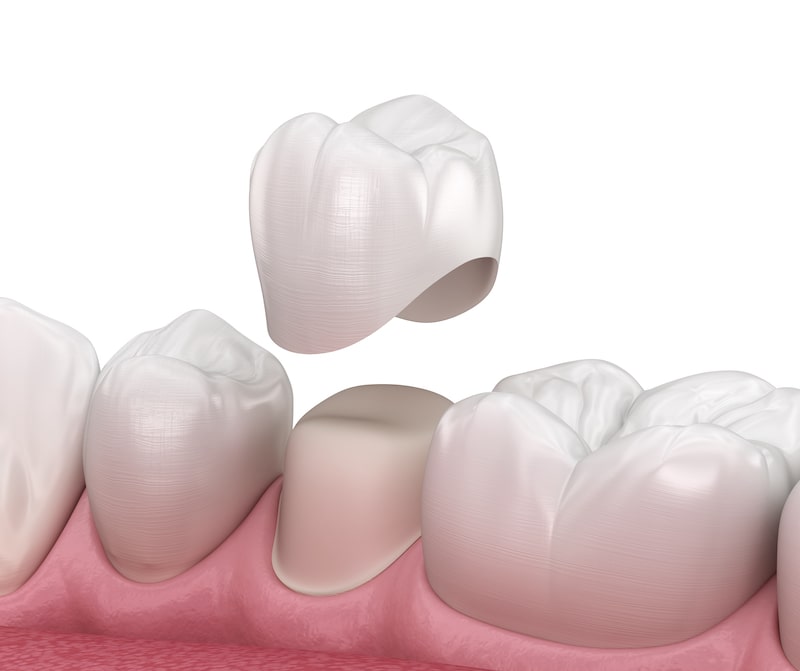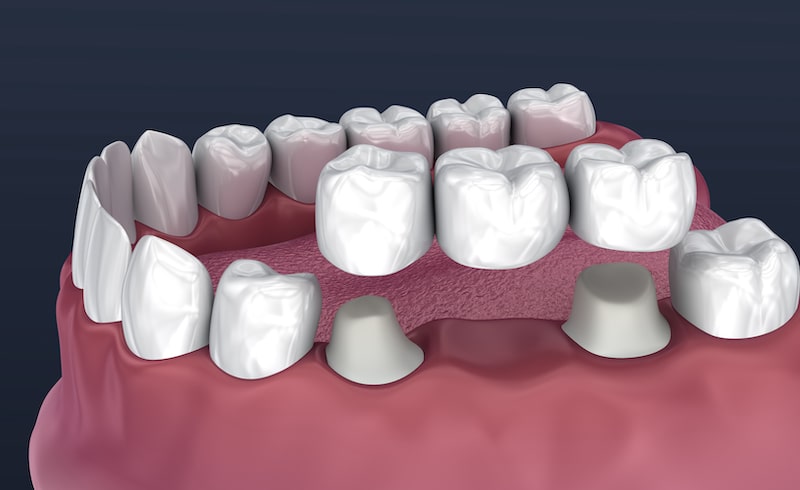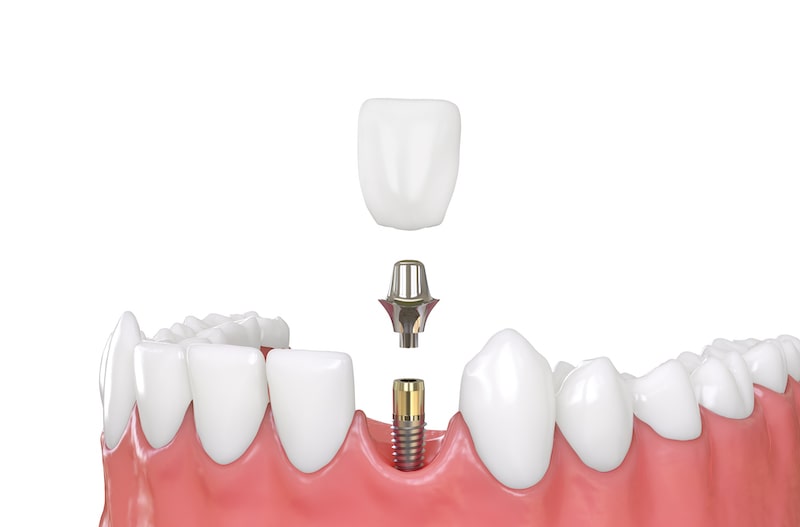Posted July 31, 2023 in Dental Crowns
4 Minute Read:
Let’s face it: going to the dentist can be daunting, especially if you think something might be wrong with your teeth. However, when a tooth is chipped, damaged, or loose, it’s always best to seek care as soon as possible to avoid infection or structural issues.

This article will discuss the ins and outs of three popular treatment options for damaged or missing teeth: the dental crown, bridge, and implant. We’ll shed some light on each so you can feel confident seeking the dental care you deserve.
What Is a Dental Crown?
Dental crowns are essentially tooth-shaped caps made of various materials — a combination of metals, porcelain, gold, and resin — that protect damaged teeth. Nowadays, all-porcelain crowns are the go-to option for their safety, durability, and aesthetic appeal.
Whether your tooth has weakened over time or has external damage like a chip or crack, a crown might be a viable option your dentist offers. Dental crowns are also used in cases of root canal therapy or large fillings that would otherwise weaken the tooth structure.
When Are Dental Crowns the Best Option?
Your dentist may suggest a crown if you have a crack or chip in your tooth that is too large for a filling alone. Crowns are individual caps that cover a single tooth, so they are a more focused form of protection and structure. They can support additional dental procedures such as root-canal-treated teeth or hold dental implants and bridges in place.
What Are the Drawbacks of Dental Crowns?
Additionally, something else to consider is that crowns are not as long-lasting as some other options. However, Gentle Care Dentistry offers a 5-year guarantee for dental crowns, which can put your mind at ease when considering this option.
What Is a Dental Bridge?

Often, crowns and bridges are part of the same treatment. While a crown is a cap for one individual tooth, a dental bridge can cover one or more missing teeth. Two crowns act as anchors, with the bridge linking them together, covering the space of the missing tooth (teeth) with artificial pontics.
When Are Bridges the Best Option?
Bridges are a good option when a larger area in the mouth has missing or damaged teeth. Like crowns, they are a natural-looking option for tooth loss — your dentist can match the color of crowns and bridges to your natural teeth, making them blend into your smile. A dental bridge also substantially supports your jaw structure and limits your natural teeth from crowding gaps, making it an excellent option for improving speech, chewing, and comfort.
What Are the Drawbacks to Dental Bridges?
The dental bridge may weaken if your natural teeth become damaged or decayed. The surrounding gum area and the bridge must be cleaned, as bacteria can cause infection.
Crowns and Bridges With Dental Implants
Now that we’ve covered bridges and crowns separately, we’ll discuss a solution that often encompasses all three: the dental implant.
What Is a Dental Implant?

Dental implants are yet another option for replacing missing teeth. Implants are a long-term solution that your dentist or oral surgeon surgically installs into your jawbone. The implant is inserted into your gums through a small incision, and after a few months, your jawbone fuses with the new material. At this point, your dentist will attach the abutment (false tooth/attachment) before attaching a crown or bridge.
When Are Dental Implants the Best Option?
As mentioned, the dental implant is a nearly permanent solution to missing teeth. Once the jawbone fuses with the implanted device, it stays there! While the process takes longer than bridges or crowns, it may be worth it for those thinking in the long term. Additionally, dental implants can aid in the installation of bridges.
What Are the Drawbacks to Implants?
With the installation of the implant, waiting for the jaw to fuse, and then adding the final crown or bridge, the dental implant may take a few months to complete from start to finish. For this reason, it may not be the best option for those who want a quick solution to missing teeth or gaps.
Want to Learn More About Crowns and Bridges?
If you’d like to learn more about crowns, bridges, and dental implants in Las Cruces, New Mexico, call Gentle Care Dentistry at (575) 524-3722, or fill out the contact form to request an appointment.